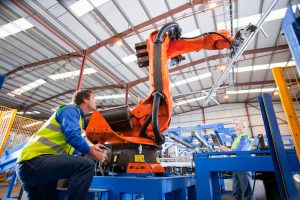Preventing manual handling injuries in your workplace (Part 2)
Manual handling injury and work-related musculoskeletal disorder (WMSD) can occur anywhere in the workplace no matter what industry you are in. It is the most common type of injury experienced in the workplace and can have serious consequences for the person who has been injured.
Work Health and Safety regulations states that employers have a responsibility for managing risk from Hazardous Manual Tasks (HMT) which can cause WMSD. A detailed assessment of what HMT risks exist should be the first step in planning an effective control. The risk assessment process should determine:
- How severe a risk is
- Whether any existing control measures are effective
- What action you should take to control the risk, and
- How urgently the action needs to be taken

Your workers need to be actively involved in the risk assessment process
Ideally, the workers themselves should be consulted in the risk assessment, as they are the experts in performing their job. A good manual handling program should provide the framework for assisting workers to identify HMT risks and controls within their own workplace. Furthermore, worker consultation would give your employees a sense of ownership and commitment to use any controls implemented.
Applying the hierarchy of risk control
Areas for analysis when evaluating the risks and designing controls for HMT include:
- Posture, forces, movement and vibration relating to the tasks
- Duration and frequency of the tasks
- Environmental conditions that may affect the worker performing the tasks
- Design, layout and system of the work area
- The Nature (size, weight and number) of the person, animal or item being handled.
The hierarchy of risk controls must be applied when designing solutions. Eliminating or reducing the need to perform HMT is the most effective way to manage risks and should be the key goal during the design and planning stage of the task. Hazards and risks can then be ‘designed out’ before they are introduced to the workplace.
When it is not practical to eliminate a hazard, risks must then be minimised by either:
- Substituting the tasks with another safer one
- Engineering controls involving a physical change to the workplace itself
The installation of lifting devices, using machines to perform the task and redesigning the workplace are all examples of engineering controls.

Using machines to lift objects will ensure workers are not exposed to manual handling injuries
Administrative controls, such as employee training, should be applied alongside engineering controls. Traditional manual handling training which tend to focus on safe lifting techniques are ineffective by itself. Instead, workers should be trained in how to identify hazards and risks, and how to apply strategies and controls to overcome them. Furthermore, training alone as a control is not effective and cannot overcome poor working conditions.
Rethinking the traditional approach toward HMT risk management
Current research have shown that traditional practices of managing HMT are inadequate and need to be improved.
- Conventional HMT management tends to focus only on the single, one off exposure to the hazard causing WMSD. This is partly created by the workers compensation system which requires workers to provide evidence of one causative incident when making claims. However, research has shown that WMSD more commonly arises from a cumulative exposure to one or more hazards over an extended period*. Therefore a more comprehensive risk management approach is needed that considers all aspects of an individual’s work, not just on a few seemingly high risks tasks.
- Standard HMT management focuses only on physical hazards and fails to consider psychosocial hazards which can also lead to WMSD*. Psychosocial hazards exists within the social context of the work environment and include high demands on the worker from high workloads, long working hours, poor job design, low levels of job control, high pace of work, conflicting work demands, communications with management, being valued, health and safety culture, and relationships with colleagues and supervisors.

Psychosocial hazards on workers can lead to a manual handling injury
Thus a change in HMT risk management style is needed which include:
- A shift from focusing on a single task or event as causing WMSD, into a more comprehensive systematic approach that examines all aspects of an individual’s work
- Moving away from analysing only the physical aspects of the work, but taking into account both physical and psychosocial hazards as well.

A wholistic risk assessment is needed instead of only analysing individual task
A successful HMT management program requires a commitment from management, and employers need to work together with their workers to identify HMT hazards and apply controls to mitigate them. Proactively managing risks will not only prevent injuries, but also bring manifold benefits to your business by increased productivity and morale where workers feel their employers care about their work conditions, health and wellbeing.
*Oakman, J., Clune, S., Stuckey, R., 2019, ‘Work-related Musculoskeletal Disorders in Australia’, Safe Work Australia.
**Oakman, J., Chan, S., March 2015, ‘Risk Management: Where should we target strategies to reduce work-related musculoskeletal disorders?’ Safety Science, Vol 73, p99-105.











